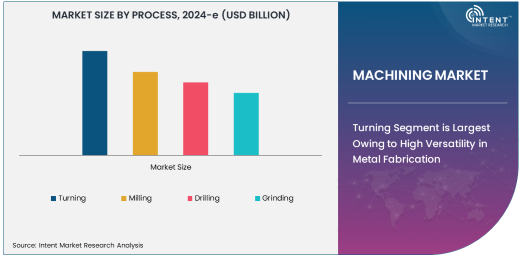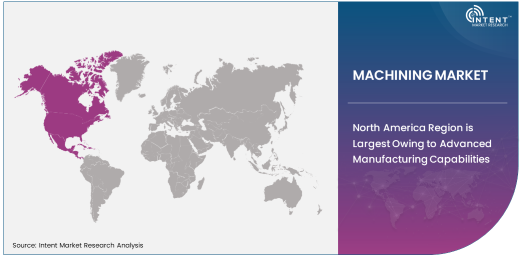As per Intent Market Research, the Machining Market was valued at USD 82.7 Billion in 2024-e and will surpass USD 131.1 Billion by 2030; growing at a CAGR of 6.8% during 2025-2030.
The machining market has emerged as a cornerstone of precision manufacturing across various industries. As technological advancements continue to drive innovation, machining processes such as turning, milling, and drilling are becoming increasingly sophisticated. Industries like automotive, aerospace, and manufacturing are leveraging advanced machining technologies to produce high-precision components efficiently. With the growing demand for customized and complex parts, the machining market is poised for sustained growth, fueled by the adoption of advanced technologies and the need for quality, durability, and innovation.
Turning Segment is Largest Owing to High Versatility in Metal Fabrication
The turning segment is the largest in the machining market due to its versatility in handling various types of materials and producing complex geometries. This process is widely used across industries such as automotive and aerospace, where precision and repeatability are critical. With advancements in CNC turning machines, the accuracy and speed of this process have significantly improved, making it the go-to solution for creating cylindrical parts, shafts, and components with intricate designs.

Metal Material is Largest Owing to Widespread Use in Industrial Applications
The use of metal as a primary material in machining is the largest segment, driven by its extensive application in industrial sectors such as automotive, aerospace, and manufacturing. Metal machining offers durability, strength, and reliability, essential for high-stress and high-performance components. Steel, aluminum, and titanium are particularly popular due to their superior mechanical properties, making metal the dominant material used in machining processes across industries.
CNC Machining is Fastest Growing Owing to Precision and Automation
CNC machining is the fastest-growing technology segment within the machining market, attributed to its ability to automate complex operations while maintaining high precision. This technology eliminates human error and enhances efficiency, allowing for the production of complex parts with reduced setup times. The adoption of CNC machining is accelerating across industries due to its ability to handle both small-scale and large-scale manufacturing with enhanced control over quality and customization.
Automotive End-User Industry is Largest Owing to High Demand for Custom Parts
The automotive industry remains the largest end-user segment in the machining market, driven by the growing demand for high-quality, customized automotive parts. From engine components to precision transmission parts, automotive manufacturers rely heavily on machining technologies to produce intricate, high-precision components that meet industry standards. Innovations in automotive engineering continue to drive the need for advanced machining solutions, ensuring that this segment leads in terms of volume and revenue.
North America Region is Largest Owing to Advanced Manufacturing Capabilities
North America holds the largest share of the machining market, owing to its robust manufacturing sector and emphasis on innovation in machining technologies. The region is home to leading automotive, aerospace, and manufacturing companies that leverage cutting-edge machining solutions to maintain a competitive edge. Additionally, the integration of Industry 4.0 and smart manufacturing practices has further fueled the adoption of advanced machining technologies across North America.

Competitive Landscape and Leading Companies
The machining market is highly competitive, with key players continuously innovating to meet the evolving needs of industries. Companies like Siemens, DMG Mori, Mazak, and Haas Automation are at the forefront, offering cutting-edge solutions for various machining applications. These firms are investing heavily in R&D to improve machining accuracy, automation, and efficiency, thereby driving advancements in the market. With increasing demand for customized and high-performance components, competition is expected to intensify as technology continues to evolve.
Recent Developments:
- Siemens launched a new line of high-precision CNC machines for automotive and aerospace applications.
- DMG Mori expanded its portfolio with a smart manufacturing solution focused on automation and sustainability.
- Mazak announced the development of an advanced additive manufacturing machine for aerospace components.
- Haas Automation acquired a leading tool management software provider to enhance manufacturing process efficiency.
- Doosan Machine Tools collaborated with robotics companies to introduce collaborative machining solutions for industrial applications.
List of Leading Companies:
- Siemens
- DMG Mori
- Haas Automation
- Mazak
- FANUC
- Hyundai WIA
- Okuma
- Doosan Machine Tools
- Yamazaki Mazak
- Schuler Group
- Makino
- Brother Industries
- Emirates Machine Tools
- JTEKT Corporation
- Gleason
Report Scope:
|
Report Features |
Description |
|
Market Size (2024-e) |
USD 82.7 Billion |
|
Forecasted Value (2030) |
USD 131.1 Billion |
|
CAGR (2025 – 2030) |
6.8% |
|
Base Year for Estimation |
2024-e |
|
Historic Year |
2023 |
|
Forecast Period |
2025 – 2030 |
|
Report Coverage |
Market Forecast, Market Dynamics, Competitive Landscape, Recent Developments |
|
Segments Covered |
Machining Market By Process (Turning, Milling, Drilling, Grinding), Material (Metal, Plastic, Composite), Technology (Conventional Machining, CNC Machining, Additive Manufacturing), and End-User Industry (Automotive, Aerospace, Manufacturing, Oil & Gas) |
|
Regional Analysis |
North America (US, Canada, Mexico), Europe (Germany, France, UK, Italy, Spain, and Rest of Europe), Asia-Pacific (China, Japan, South Korea, Australia, India, and Rest of Asia-Pacific), Latin America (Brazil, Argentina, and Rest of Latin America), Middle East & Africa (Saudi Arabia, UAE, Rest of Middle East & Africa) |
|
Major Companies |
Siemens, DMG Mori, Haas Automation, Mazak, FANUC, Hyundai WIA, Okuma, Doosan Machine Tools, Yamazaki Mazak, Schuler Group, Makino, Brother Industries, Emirates Machine Tools, JTEKT Corporation, Gleason |
|
Customization Scope |
Customization for segments, region/country-level will be provided. Moreover, additional customization can be done based on the requirements |
|
1. Introduction |
|
1.1. Market Definition |
|
1.2. Scope of the Study |
|
1.3. Research Assumptions |
|
1.4. Study Limitations |
|
2. Research Methodology |
|
2.1. Research Approach |
|
2.1.1. Top-Down Method |
|
2.1.2. Bottom-Up Method |
|
2.1.3. Factor Impact Analysis |
|
2.2. Insights & Data Collection Process |
|
2.2.1. Secondary Research |
|
2.2.2. Primary Research |
|
2.3. Data Mining Process |
|
2.3.1. Data Analysis |
|
2.3.2. Data Validation and Revalidation |
|
2.3.3. Data Triangulation |
|
3. Executive Summary |
|
3.1. Major Markets & Segments |
|
3.2. Highest Growing Regions and Respective Countries |
|
3.3. Impact of Growth Drivers & Inhibitors |
|
3.4. Regulatory Overview by Country |
|
4. Machining Market, by Process (Market Size & Forecast: USD Million, 2023 – 2030) |
|
4.1. Turning |
|
4.2. Milling |
|
4.3. Drilling |
|
4.4. Grinding |
|
5. Machining Market, by Material (Market Size & Forecast: USD Million, 2023 – 2030) |
|
5.1. Metal |
|
5.2. Plastic |
|
5.3. Composite |
|
6. Machining Market, by Technology (Market Size & Forecast: USD Million, 2023 – 2030) |
|
6.1. Conventional Machining |
|
6.2. CNC Machining |
|
6.3. Additive Manufacturing |
|
7. Machining Market, by End-User Industry (Market Size & Forecast: USD Million, 2023 – 2030) |
|
7.1. Automotive |
|
7.2. Aerospace |
|
7.3. Manufacturing |
|
7.4. Oil & Gas |
|
8. Regional Analysis (Market Size & Forecast: USD Million, 2023 – 2030) |
|
8.1. Regional Overview |
|
8.2. North America |
|
8.2.1. Regional Trends & Growth Drivers |
|
8.2.2. Barriers & Challenges |
|
8.2.3. Opportunities |
|
8.2.4. Factor Impact Analysis |
|
8.2.5. Technology Trends |
|
8.2.6. North America Machining Market, by Process |
|
8.2.7. North America Machining Market, by Material |
|
8.2.8. North America Machining Market, by Technology |
|
8.2.9. North America Machining Market, by End-User Industry |
|
8.2.10. By Country |
|
8.2.10.1. US |
|
8.2.10.1.1. US Machining Market, by Process |
|
8.2.10.1.2. US Machining Market, by Material |
|
8.2.10.1.3. US Machining Market, by Technology |
|
8.2.10.1.4. US Machining Market, by End-User Industry |
|
8.2.10.2. Canada |
|
8.2.10.3. Mexico |
|
*Similar segmentation will be provided for each region and country |
|
8.3. Europe |
|
8.4. Asia-Pacific |
|
8.5. Latin America |
|
8.6. Middle East & Africa |
|
9. Competitive Landscape |
|
9.1. Overview of the Key Players |
|
9.2. Competitive Ecosystem |
|
9.2.1. Level of Fragmentation |
|
9.2.2. Market Consolidation |
|
9.2.3. Product Innovation |
|
9.3. Company Share Analysis |
|
9.4. Company Benchmarking Matrix |
|
9.4.1. Strategic Overview |
|
9.4.2. Product Innovations |
|
9.5. Start-up Ecosystem |
|
9.6. Strategic Competitive Insights/ Customer Imperatives |
|
9.7. ESG Matrix/ Sustainability Matrix |
|
9.8. Manufacturing Network |
|
9.8.1. Locations |
|
9.8.2. Supply Chain and Logistics |
|
9.8.3. Product Flexibility/Customization |
|
9.8.4. Digital Transformation and Connectivity |
|
9.8.5. Environmental and Regulatory Compliance |
|
9.9. Technology Readiness Level Matrix |
|
9.10. Technology Maturity Curve |
|
9.11. Buying Criteria |
|
10. Company Profiles |
|
10.1. Siemens |
|
10.1.1. Company Overview |
|
10.1.2. Company Financials |
|
10.1.3. Product/Service Portfolio |
|
10.1.4. Recent Developments |
|
10.1.5. IMR Analysis |
|
*Similar information will be provided for other companies |
|
10.2. DMG Mori |
|
10.3. Haas Automation |
|
10.4. Mazak |
|
10.5. FANUC |
|
10.6. Hyundai WIA |
|
10.7. Okuma |
|
10.8. Doosan Machine Tools |
|
10.9. Yamazaki Mazak |
|
10.10. Schuler Group |
|
10.11. Makino |
|
10.12. Brother Industries |
|
10.13. Emirates Machine Tools |
|
10.14. JTEKT Corporation |
|
10.15. Gleason |
|
11. Appendix |
A comprehensive market research approach was employed to gather and analyze data on the Machining Market. In the process, the analysis was also done to analyze the parent market and relevant adjacencies to measure the impact of them on the Machining Market. The research methodology encompassed both secondary and primary research techniques, ensuring the accuracy and credibility of the findings.
.jpg)
Secondary Research
Secondary research involved a thorough review of pertinent industry reports, journals, articles, and publications. Additionally, annual reports, press releases, and investor presentations of industry players were scrutinized to gain insights into their market positioning and strategies.
Primary Research
Primary research involved conducting in-depth interviews with industry experts, stakeholders, and market participants across the E-Waste Management ecosystem. The primary research objectives included:
- Validating findings and assumptions derived from secondary research
- Gathering qualitative and quantitative data on market trends, drivers, and challenges
- Understanding the demand-side dynamics, encompassing end-users, component manufacturers, facility providers, and service providers
- Assessing the supply-side landscape, including technological advancements and recent developments
Market Size Assessment
A combination of top-down and bottom-up approaches was utilized to analyze the overall size of the Machining Market. These methods were also employed to assess the size of various subsegments within the market. The market size assessment methodology encompassed the following steps:
- Identification of key industry players and relevant revenues through extensive secondary research
- Determination of the industry's supply chain and market size, in terms of value, through primary and secondary research processes
- Calculation of percentage shares, splits, and breakdowns using secondary sources and verification through primary sources
.jpg)
Data Triangulation
To ensure the accuracy and reliability of the market size, data triangulation was implemented. This involved cross-referencing data from various sources, including demand and supply side factors, market trends, and expert opinions. Additionally, top-down and bottom-up approaches were employed to validate the market size assessment.
NA
